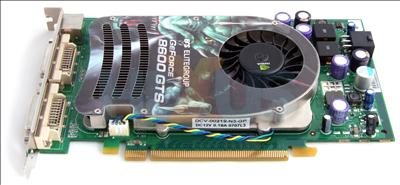Card appearance and thoughts
A little recap on GeForce 8600 GTS first.
The NVIDIA chopping machine has been dusted down and brought into action. Its job was to take GeForce 8800 as a technology base and pare it down to meet a certain price point whilst keeping all the DX10 gubbins intact.
In terms of pure performance the chopper has been busier than we'd like, really. Unified scalar shader units are down to 32 from the range-topping 128. The memory bus is down from 384-bit to a meagre 128-bit, and ROPs have been harvested from 24 to 8. Sounds all bad, right?
There is some good news with the fact that the texturing potential of G84 has been doubled, per clock cycle, when compared to G80. The later introduction of G84 also sees a process shrink to 80nm, and NVIDIA bolsters the multimedia performance of the SKU by introducing its VP2 processor, which aids in the usually CPU-intensive (and expensive) HD decoding task by providing hardware-assisted acceleration. Finally, the SKU's dual-DVI outputs are both dual-link-capable and can run HDCP-protected content at up to 2560x1600.
You lose a chunk of performance, naturally, but you gain some extra features that even the mighty GeForce 8800 Ultra is bereft of.
Moving swiftly on over to ECS' interpretation.
Default-clocked GeForce 8600 GTS cards run at 675/1450/2000 for the core/shader/memory clocks, respectively. Those speeds, we reckon, are pretty conservative, so ECS, like many other AIBs, indulges in a spot of overclocking. The N8600GTS-256MX ships with 720/1450/2200 clocks. We're impressed at just how high the latest batch of Samsung GDDR3 is able to go and the core increase isn't to be sniffed at, but ECS has left the shader clocks untouched.
The angled shot highlights the single-slot-taking cooler which is extremely quiet in 2D mode but rather louder than we'd like when running under 3D load.
The front-end shot, showing a 6-pin PCIe connector, informs us that this midrange part is still quite power thirsty.
Both DVI ports are dual-link and (dual-link) HDCP compliant. The DIN socket can only output video, though.
The SLI connector is the only aspect worth pointing out on the back.














